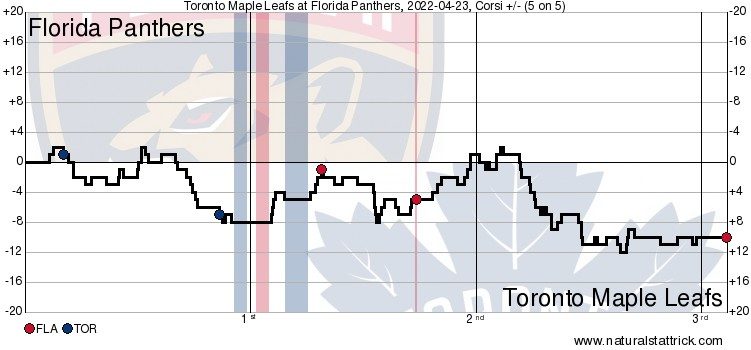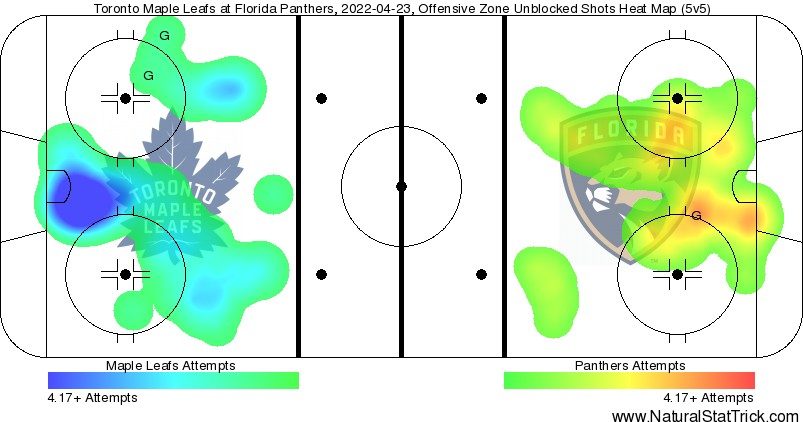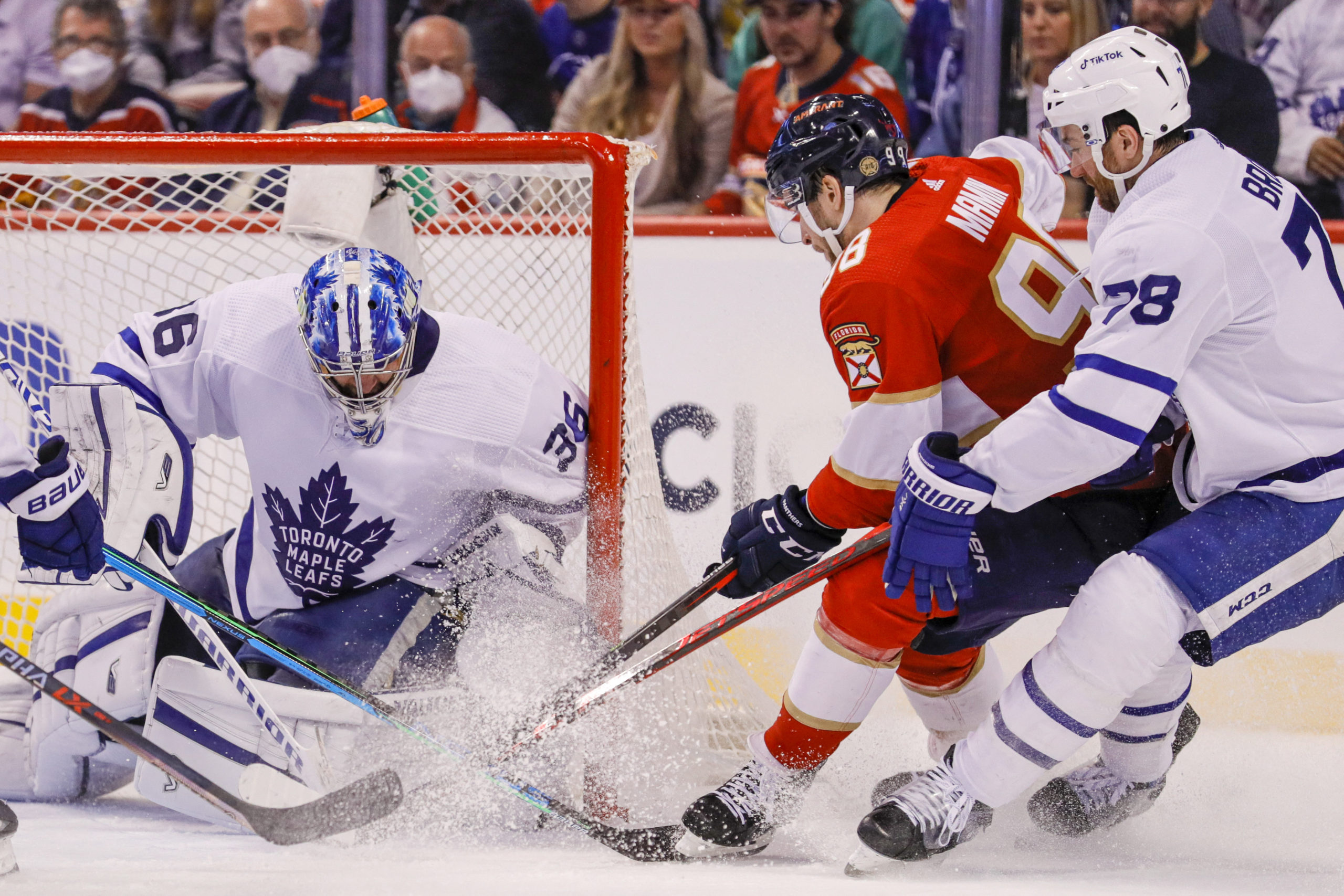The Toronto Maple Leafs got Auston Matthews back in the lineup tonight, but they were unable to snap the Florida Panthers’ (now) 13-game winning streak, dropping a tight game by a score of 3-2 in overtime.
The Leafs re-inserted Matthews into the lineup but quickly lost Michael Bunting to an injury during the contest. Despite losing their top-line LW early on, the Leafs played a strong game, out-chancing/shooting the Panthers and building a 2-0 lead on goals from Mitch Marner and Justin Holl.
Florida’s fearsome offense clawed back in the second period before the brilliance of Sergei Bobrovsky pushed the game to overtime, where Brandon Montour’s winner beat Jack Campbell.
Your game in 10:
1. Tonight’s game got off to a pretty quick start. Not long after we were informed that the HNIC broadcast was delayed due to technical troubles — the Panthers TV broadcast was plugged in temporarily — TJ Brodie intelligently shot a puck off the end boards from the neutral zone and it bounced straight to Mitch Marner, who hammered a shot by Sergei Bobrovsky:
MITCH MARNER 🚨
FROM THE RIGHT CIRCLE pic.twitter.com/PsryNLiMkn
— Omar (@TicTacTOmar) April 23, 2022
This was not a particularly great goal for Sergei Bobrovsky allow, although it’s another example of Marner’s improved shooting ability. Now up to 35 goals on the season, he continues to obliterate his previous career-high.
It was a hot start for the Leafs, who kept the momentum with a couple more chances pretty quickly after. William Nylander set up Kyle Clifford for a chance but Bobrovsky stood tall:
Clifford gets a point-blank opportunity from Nylander pic.twitter.com/BWLuMbcbHl
— Omar (@TicTacTOmar) April 23, 2022
I thought Clifford and Wayne Simmonds had a solid first period offensively, creating several scoring chances at 5v5 in the game in limited ice time. Those grizzled veterans have had much more jump in the past couple of weeks on the offensive end, which is nice to see.
Unfortunately for tonight, defense was also a problem for them, and they didn’t play much after the first period.
2. The Leafs added a second goal in the first period as they continued to keep the foot on the gas. Florida generated a few looks on Jack Campbell in the opening 20, including a deflected knuckle-puck that rang off the crossbar early, but they didn’t register a shot on goal until the midway point.
Overall, the Leafs were the better team in the first and they scored a second goal as a result of their efforts. Justin Holl sent a diagonal pass into the crease, looking for Pierre Engvall, and it deflected in off the skate of Radko Gudas.
It was a smart play from Holl to put the puck in a dangerous area, and the Puck Luck Gods rewarded him with a goal. Credit to David Kämpf on the play as well for bringing the puck up in transition, establishing possession in the offensive zone, and finding Holl:
Kämpf rushes the puck into the zone and gets it to Holl pic.twitter.com/e23odUu7IZ
— Omar (@TicTacTOmar) April 23, 2022
Kämpf picked up a primary assist there, his 15th of the season and his 26th point of the year, which is a career-high.
3. One reason for the Maple Leafs’ success in the opening frame may have been their concerted effort to make the game a more dump-and-chase, forechecking-based game. The last meeting of these two teams — the 7-6 Panthers victory in OT back in early April — was an all-out track meet, which is the sort of game the Panthers relish.
Few teams in the league are built to keep up with them, and while I’d argue that the Leafs are pretty well equipped for it, you don’t want the opponent to dictate their preferred style of play. Florida’s absurdly-deep forward group and smooth-skating defensemen mean they thrive in those conditions, and the Leafs were better off getting the Panthers out of their comfort zone.
That’s more or less what they did in the first period, limiting rush chances against, chipping the puck in, and remaining content to play a much more methodical and controlled possession game than last time. The frenetic, heart-stopping pace of the previous meeting was absent for much of this one, although there were still plenty of chances off the cycle for both teams, with the occasional rush mixed in. Overall, the more defensively-sound approach paid dividends for the Leafs.
Another element I liked throughout the game — and first noticed in the opening 20 minutes — were the active defensive sticks of the Maple Leafs. Whether it was forwards backchecking, or defensemen stepping up to challenge shooters, the Leafs routinely got their sticks in the way to block shots or take pucks away. In some cases, like this one from Marner in the third period, it was their bodies, too:
Mitch Marner: I CALL UPON THE POWER OF T.J. BRODIE pic.twitter.com/6arjup2pUP
— Omar (@TicTacTOmar) April 24, 2022
The defensive buy-in from the whole team tonight was superb. As a result, the Panthers didn’t often slice through the Leafs defense and shots on Campbell tended to come from further out.
If you want to know how the Leafs held the NHL’s most explosive offense to 2.11 expected goals in nearly 55 minutes at 5v5 tonight (the Panthers entered tonight averaging 3.29 xGF/60 minutes at 5v5 per Evolving Hockey), it was a schematic effort to slow the game down to cut down on rush chances against as well as a team-wide effort to be in sound defensive positioning and use active sticks to deny passes and shots.
4. The Leafs received two power-play opportunities in this game, both of which came in the stretch of the game from the tail end of the first period to the early second. The first power play didn’t last terribly long before Auston Matthews was hit with a marginal hooking call, but the Leafs still generated two good chances, one of which was this slip pass from AM34 to John Tavares:
Tavares' turn to get a scoring chance pic.twitter.com/YSLz7K2CCI
— Omar (@TicTacTOmar) April 23, 2022
Bobrovsky also stopped a Mitch Marner rebound blast upstairs not long after.
The Leafs’ second power play produced a good look for William Nylander out front after a great dig on the forecheck from Tavares before Auston Matthews fired two shots from just inside the circle. Neither went in:
Matthews was just wide on that shot pic.twitter.com/syeMxDlWBe
— Omar (@TicTacTOmar) April 24, 2022
While Toronto didn’t score a PPG in this game, the process looked pretty good. The Leafs generated three scoring chances and two high-danger looks in just over three minutes of PP time per Natural Stat Trick. No major complaints.
5. The second period was not as sharp for the Leafs, who were perhaps a little too passive. They were still trying to slow the game down, but they took a little of the edge off offensively, opening the door for the dangerous Panthers offense to claw back into the game.
Justin Holl slid down the wall in the offensive zone to keep the play alive, but he quickly turned it over. Mason Marchment broke out into the neutral zone and attacked William Nylander, who was playing defense in support of Holl. Nylander’s defensive attempt was, um… not great:
Aleksander Barkov puts Florida on the board pic.twitter.com/dBeumqy6SD
— Omar (@TicTacTOmar) April 24, 2022
Nylander has to get a piece of Marchment’s body if he’s not going to get any of the puck. Instead, he was basically a traffic cone on the play.
Jack Campbell used a smart poke check to relieve the immediate pressure, but it went right to Aleksander Barkov, who wired it home. Not a lot the goaltender could do on that one.
6. There’s been a lot of focus on the power play recently, which I don’t have major issues with; they scored PPGs in three straight games entering tonight. As I noted earlier, the process looks good.
What I would argue isn’t getting enough attention is the penalty kill. After the Panthers went to their second PP in the later stages of the second period, it didn’t take long at all for the puck to find the back of the net. The Panthers won the opening draw, fed it around to Claude Giroux at the point, and he blasted it through everybody:
Claude Giroux ties it as his shot goes through Giordano's legs pic.twitter.com/22JSlpzX5F
— Omar (@TicTacTOmar) April 24, 2022
Duclair has a picture-perfect screen on Campbell, and Mark Giordano and Alex Kerfoot are also essentially in the same line of vision, making it something of a triple screen on the Toronto netminder. Again, there isn’t much you can expect a goalie to do in those circumstances.
Florida was 1/2 on the PP on the evening, dropping the Leafs’ PK to 27/37 in the month of April, which is just a 73% efficiency. When we account for the Leafs starting the month 4/4 on the kill, they are 23 for their last 33, which is below 70%.
The power kill element of the PK continues to function as the Leafs are still generating offensive looks shorthanded, but too many goals are going in the back of the net. What’s interesting about the PK’s struggles is that they are isolated, with seven of the 10 goals allowed shorthanded in the month of April coming against two teams: Florida and Tampa. The Panthers scored three against the Leafs in the last meeting and one tonight, while the Lightning converted on three power plays on Thursday night.
Last playoffs was a pretty clear example of how the Tampa PP can kill opponents. Still hanging in the memory bank is 2019, when the Leafs ceded seven PPGs on 16 opportunities to Boston.
Considering the path to the Eastern Conference Finals is likely Tampa/Boston followed by Florida, it’s hard to overstate how crucial the PK will be in the playoffs. Right now, it is not getting it done against those calibre of teams. This is one of the storylines I will be monitoring in the final three games.
7. The third period was a strong response from the Maple Leafs after a less than satisfactory second. The Leafs gave up a few looks to the Panthers, but they were firmly the better team. Simply put, the only reason Toronto didn’t win this game in the third was Sergei Bobrovsky.
The Leafs owned the scoring chances 15-9, the high-danger chances 8-3, and the expected goals 1.53-0.73 in the third period, per Natural Stat Trick. They continued to do a good job of slowing down Florida while creating chances for themselves the other way, although the game did open up for a couple minutes with around seven minutes to play.
With Auston Matthews and Mitch Marner joined by William Nylander on the top line, they created oodles of chances. Here was another great one for Matthews:
another close call for Matthews pic.twitter.com/620T2p3ds4
— Omar (@TicTacTOmar) April 24, 2022
I thought Matthews looked quite good in his return to the lineup; he was perhaps not totally himself — he usually scores goals — but he didn’t seem obviously hampered by an ailment for most of the game.
John Tavares got a great look on Bobrovsky in the third thanks to a terrific set up starting with Morgan Rielly that was continued by Pierre Engvall and Ilya Mikheyev:
beautiful set of passes including a clean breakout pass from Rielly pic.twitter.com/QVVlHoipyw
— Omar (@TicTacTOmar) April 24, 2022
Bobrovsky finished the game with +2.73 goals saved above expected in Evolving Hockey’s numbers and deserves a big pat on the back from his Panthers teammates.
8. The game went in to 3v3 OT, a setting where the Leafs have been mostly pedestrian and the Panthers have been world-beaters. That trend continued tonight.
The Leafs played three poor minutes of OT, routinely failing to execute passes and turning it over — a big no-no in a format where possession is so crucial. They nearly allowed the game-winner right off the jump:
JACK CAMPBELL! pic.twitter.com/g40H1vkCcR
— Omar (@TicTacTOmar) April 24, 2022
Jack Campbell made that stop to keep the Leafs in it, and they did create a decent look for John Tavares and William Nylander, but after both ended up below the goal line, it was a bad recipe going the other way:
Brandon Montour wins it in overtime
Campbell missed the poke check pic.twitter.com/VZtb0ZP76q
— Omar (@TicTacTOmar) April 24, 2022
I don’t have much of a take about the overtime having gotten to the point where I basically disregard 3v3. It is a completely different game from playoff hockey, and while it helps Florida in the standings to be 13-2 in OT this season (that’s not a typo), I don’t think it means much of anything for May. Likewise, the Leafs’ 6-6 record in OT doesn’t impact my evaluation of the squad at all knowing there will likely not be a single minute of 3v3 played in the playoffs by any team.
All of that said, should the Leafs find themselves in 3v3 again in the final three games, I think it’s time to question John Tavares‘ effectiveness in overtime. He has more skill than a lot of other forwards on the team, but his skating ability doesn’t excel in the extra open ice. He has been on the ice for both of the Panthers’ game-winners against the Leafs in OT this year.
When the team has Mikheyev, Engvall, Kerfoot, and Blackwell — several of whom are scoring at career-high rates this season — I don’t think Tavares is always one of the best options after Matthews-Marner. In any event, it’s not going to be a relevant discussion point come playoff time anyway.
9. Despite allowing the OT goal, I felt that Jack Campbell had another solid showing in this game. He was calm, confident, and poised in the crease.
I don’t put either of the first two goals on him. It’s hard to fault a goalie for any 3v3 goal allowed, although you’d have liked him to make that pokecheck. While Campbell graded out negatively in the goals saved above expected numbers for the game, he was +1.11 in Natural Stat Trick’s numbers at 5v5 and was positive overall before the 3v3. Fine by me.
Tonight was an intriguing test for him since Campbell’s only bad performance since returning from injury was against this team when he was inserted mid-game after Erik Källgren exited with an injury in the second period. Campbell allowed four goals on 22 shots in that one — the only outing he’s allowed four goals in since he returned — and that came in less than half-the-game.
I excepted that outing from my analysis of him on Thursday because of the extenuating circumstances, and tonight validated my decision to do so. Given the chance to start the game clean (as opposed to coming in while his team was reeling and coughing up a lead), Campbell was in control of the game. That first stop in OT was a highlight, as was this one in the first period:
Jack Campbell went from seeing no shots to stopping four quality scoring chances pic.twitter.com/UZwQpw4nM3
— Omar (@TicTacTOmar) April 23, 2022
Campbell is now 6-0-1 in his seven starts since returning from injury, with a .915 SV% and a 2.55 GAA in those outings. He’s looked even sharper over the last three — a .932 in those starts — and he’s posted three-straight games with a .910 SV% or better since a span across the COVID pause in December stretching into January. The Leafs’ starting goaltender seems to be rounding into form just in time for the postseason.
10. Now for the bad news: Michael Bunting exited the game in the first period after an awkward play behind the Panthers’ net:
not sure why Bunting left the game but this was one of the last moments of his shift pic.twitter.com/z9mTikg1Op
— Omar (@TicTacTOmar) April 23, 2022
Bunting’s right ankle bent awkwardly as he fell, and he was seen shaking his right leg as he skated off the ice. He did not return to the game, causing the Leafs to put Clifford and Simmonds on the shelf and essentially use three lines the rest of the way. After the game, Keefe was asked about Bunting’s status:
Sheldon Keefe says it looks like Michael Bunting will miss some time @TSN_Edge
— Mark Masters (@markhmasters) April 24, 2022
It’s obviously not what we want to hear. That said, we are now in playoff-mode, where the truth about every injury is treated like a state secret that the coaches have taken an oath to protect.
It seems likely to me that Bunting will miss the remainder of the regular season (just shooting from the hip here). The Leafs have been very cautious with both the Matthews injury and the rehab of Jake Muzzin, and I see no reason to believe they will play Bunting again before the playoffs no matter what his actual injury status. Give him nine days off and see if he’s ready to play Game 1 the first week of May.
The situation sucks, but this is hockey and injuries happen. It’s premature to suggest that Bunting will definitely miss playoff games — and this is not meant to be an exercise of fearing the worst — but the Tampa Bay Lightning won a Stanley Cup two years ago with Steven Stamkos missing nearly the entire playoffs. Great teams overcome such things and this won’t be the only injury the team will face if the Leafs are to make a deep run.
I’d like to see the following lines with Bunting out:
Nylander – Matthews – Marner
Kerfoot – Tavares – Mikheyev
Engvall – Kämpf – Blackwell
Clifford – Spezza – Simmonds
(Abruzzese)
That fourth line probably won’t be great, but if they play 6-8 minutes a night, the old goats might have enough jump to give them a few good shifts here and there.
When Nylander jumped up to the top line tonight, it was dynamite: at 5v5, they owned 97% of the xG and dominated the high-danger chances 7-0. Now, there was an extremely high offensive-zone start rate attached, but even with that little advantage, those are still dominant numbers.
The Leafs would still have a gangbusters top line with this configuration, while Kerfoot/Tavares/Mikheyev have posted good metrics together thus far. The third line would be more defensively-focused, but Engvall and Blackwell can chip in a bit of offense.
It’s not ideal, but I think it will be alright (for now). Mixing Abruzzese or even Nick Robertson is an option, too. There is always Ondrej Kaše if he were ever healthy (who knows about that).
If nothing else, this development highlights how quietly big it was for Kyle Dubas to include Colin Blackwell in the Giordano deal. That extra depth comes in handy at times like these.
Game Flow: 5v5 Shot Attempts

Heat Map: 5v5 Shot Attempts






![Craig Berube on the Leafs’ ugly win over the Islanders: “The [fourth line] provided the energy we needed, because it was low” Craig Berube, Toronto Maple Leafs head coach](https://mapleleafshotstove.com/wp-content/uploads/2024/11/craig-berube-pg-vgk-218x150.jpg)
























![Craig Berube on the Leafs’ ugly win over the Islanders: “The [fourth line] provided the energy we needed, because it was low” Craig Berube, Toronto Maple Leafs head coach](https://mapleleafshotstove.com/wp-content/uploads/2024/11/craig-berube-pg-vgk-100x70.jpg)


